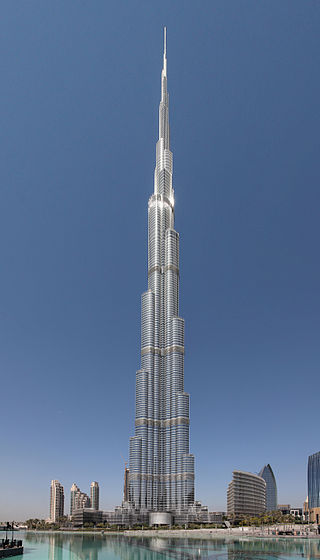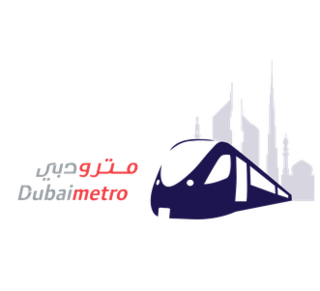
Hong Kong Tramways (HKT) is a 3 ft 6 in narrow-gauge tram system in Hong Kong. Owned and operated by RATP Dev, the tramway runs on Hong Kong Island between Kennedy Town and Shau Kei Wan, with a branch circulating through Happy Valley.

The Burj Khalifa is a skyscraper in Dubai, United Arab Emirates. It is the world's tallest structure. With a total height of 829.8 m and a roof height of 828 m (2,717 ft), the Burj Khalifa has been the tallest structure and building in the world since its topping out in 2009, surpassing Taipei 101, the holder of that status since 2004.
Emaar Properties is an Emirati real estate development company located in the United Arab Emirates. The two largest shareholders are Dubai ruler Mohammed bin Rashid Al Maktoum and the UAE's sovereign wealth fund Investment Corporation of Dubai.

The Dubai Metro is a rapid transit system in the city of Dubai, United Arab Emirates. The metro system consists of a network of two main lines: the Red Line and the Green Line. A third line, the Blue Line, is scheduled to open in 2029.

Dubai Marina, also known as Marsa Dubai, is a district in Dubai, United Arab Emirates. It is built around an artificially constructed canal along a 3-kilometre (2 mi) stretch of the Persian Gulf shoreline. In 2018 it had a population of 55,052.

Dubai Mall is the largest shopping mall in Dubai. It is the second largest mall in the world by total land area after the Iran Mall, and the 26th-largest shopping mall in the world by gross leasable area, with a total retail floor area of 350,000 m2 (3,800,000 sq ft). The mall is part of the 20-billion-dollar downtown complex called Downtown Dubai that is adjacent to the Burj Khalifa, and includes over 1,200 shops. In 2011, it was the most visited building on the planet, and attracts over 54 million visitors each year.

A double-decker tram or double-deck tram is a tram that has two levels or decks. Some double-decker trams have open tops. Double-deck trams were once popular in some European cities, like Berlin and London, throughout the British Empire countries in the early half of the 20th century including Auckland, Christchurch and Wellington in New Zealand; Hobart, Tasmania in Australia, and in parts of Asia. They are still in service or even newly introduced in Hong Kong, Alexandria, Oranjestad, Blackpool, Birkenhead, Franschhoek, Auckland and Douglas, mostly as heritage or tourist trams.
The Roads and Transport Authority (RTA) was formed by the decree number 17 for the year 2005.
The government of Dubai took a decision to diversify from a trade-based, oil-reliant economy to one that is service and tourism-oriented. This has made real estate and other developments more valuable, thus resulting in a property boom from 2004 to 2006. Construction on a large scale has turned Dubai into one of the fastest-growing cities in the world. There are a number of large-scale projects which are currently under construction or are to be constructed in the future. Due to the heavy construction which is taking place in Dubai, 30,000 construction cranes, which are 25% of cranes worldwide, are operating in Dubai. Due to the burst of construction, Dubai has acquired various building-related records, which include: the world's tallest tower, the world's largest shopping mall, the world's largest fountain and the world's tallest hotel. Also under construction is Dubailand, which will be almost twice the size of the Walt Disney World Resort.
Since the early 2000s, Doha, the capital of Qatar has been undergoing an extensive expansion in its transportation network including the addition of new highways, the construction of a new airport, and the addition of the Doha metro. These projects are meant to keep up with the population's rapid growth, which has strained the country's current infrastructure.

St Werburgh's Road is a tram stop on the South Manchester Line (SML) and Airport Line of Greater Manchester's light-rail Metrolink system in Chorlton-cum-Hardy, Manchester. It was built as part of Phase 3a of the network's expansion and opened on 7 July 2011.

Downtown Dubai or The DubaiDowntown is a large-scale, mixed-use complex in Dubai, United Arab Emirates. It was developed by the Emaar real estate development company. Before 2000, this area was called Umm Al Tarif It is home to some of the city's most notable landmarks, including Burj Khalifa, Dubai Mall, and The Dubai Fountain. It covers an area of 2 square kilometres (0.77 sq mi), at an estimated cost of US$20 billion upon completion and, as of 2017, has a population of 13,201.

There are many tourist attractions in Dubai, resulting from the large scale construction boom. Dubai received 14 million tourists from all around the world in 2015. Euromonitor ranked the world's 150th most visited city by international tourists in 2009; Dubai ranked 7th. Dubai welcomed 14.36M visitors in 2022. Dubai's economy relies on many sections of the "state", one of the most important being tourism, in 2014 total 70,475,636 passengers traveled through Dubai Airport.

The Dubai Fountain contains a choreographed fountain system located on the 12-hectare (30-acre) artificial Burj Khalifa Lake, at the center of the Downtown Dubai development in Dubai, United Arab Emirates. It was designed by WET Design, a California-based company also responsible for the fountains at the Bellagio Hotel Lake in Las Vegas. Illuminated by 6,600 lights and 25 colored projectors, it is 275 m (902 ft) long and shoots water up to 500 ft (152.4 m) into the air accompanied by a range of classical to contemporary Arabic and world music. It was built at a cost of Dhs 800 million (US$218 million).

The Dubai Tram is a tramway located in Al Sufouh, Dubai, United Arab Emirates. It runs for 14.5 kilometers (9.0 mi) along Al Sufouh Road from Dubai Marina to the Palm Jumeirah and Al Sufouh. The tram connects with the DMCC and Sobha Realty stations of the Dubai Metro's Red Line, and two more stations are expected to connect with the tram in the future. The Dubai Tram is also connected with the monorail of the Palm Jumeirah at the entrance of the Palm from Sufouh Road.

The Burj Vista also known as The Grand Boulevard Tower is a twin-tower skyscraper complex in Dubai, United Arab Emirates consisting of a 66-story tower and 20-story tower. Both towers are residential and consist of 520 and 120 apartments respectively. It was designed by Adrian Smith, who also designed Burj Khalifa.

Trams operated in Hobart, the capital of the Australian state of Tasmania, between 1893 and 1960. The city had an extensive and popular system that reached most of its suburbs. It was the first complete electric tram system in the Southern Hemisphere, and the only one in Australia to operate double-decker trams.

Burj Khalifa/Dubai Mall is a rapid transit station on the Red Line of the Dubai Metro in Dubai. It is one of the busiest stations of the Dubai Metro, with over 3.180 million passengers in 2011.

The Oranjestad Streetcar and is a single-track tram line in Oranjestad, the capital city of Aruba. It is owned and operated by Arubus, the national public transportation company. It was built as a key component of a larger project to upgrade the main retail areas of the town, other aspects of which included pedestrianization of streets, planting of trees, installation of ornamental street lighting and resurfacing of streets and sidewalks.
Trams have been used since the 19th century, and since then, there have been various uses and designs for trams around the world. This article covers the many design types, most notably the articulated, double-decker, drop-centre, low-floor, single ended, double-ended, rubber -tired, and tram-train; and the various uses of trams, both historical and current, most notably cargo trams, a dog car, hearse tram, maintenance trams, a mobile library service, a nursery tram, a restaurant tram, a tourist tram, and as mobile offices.















